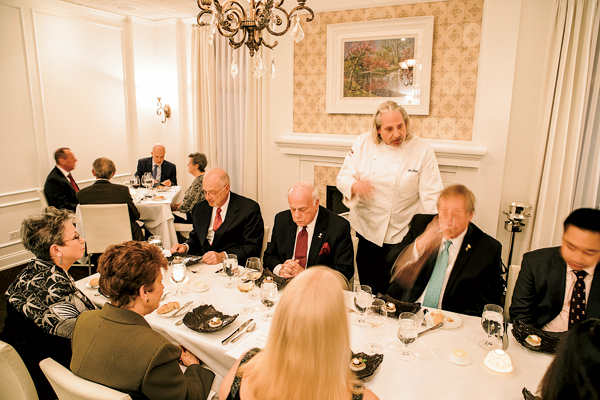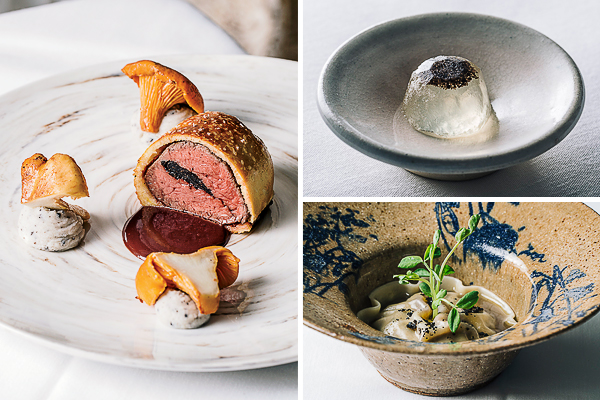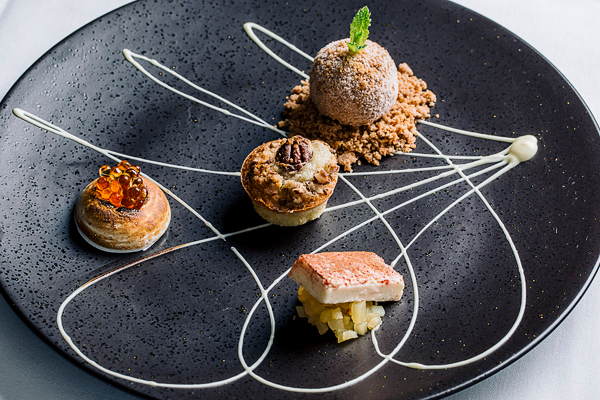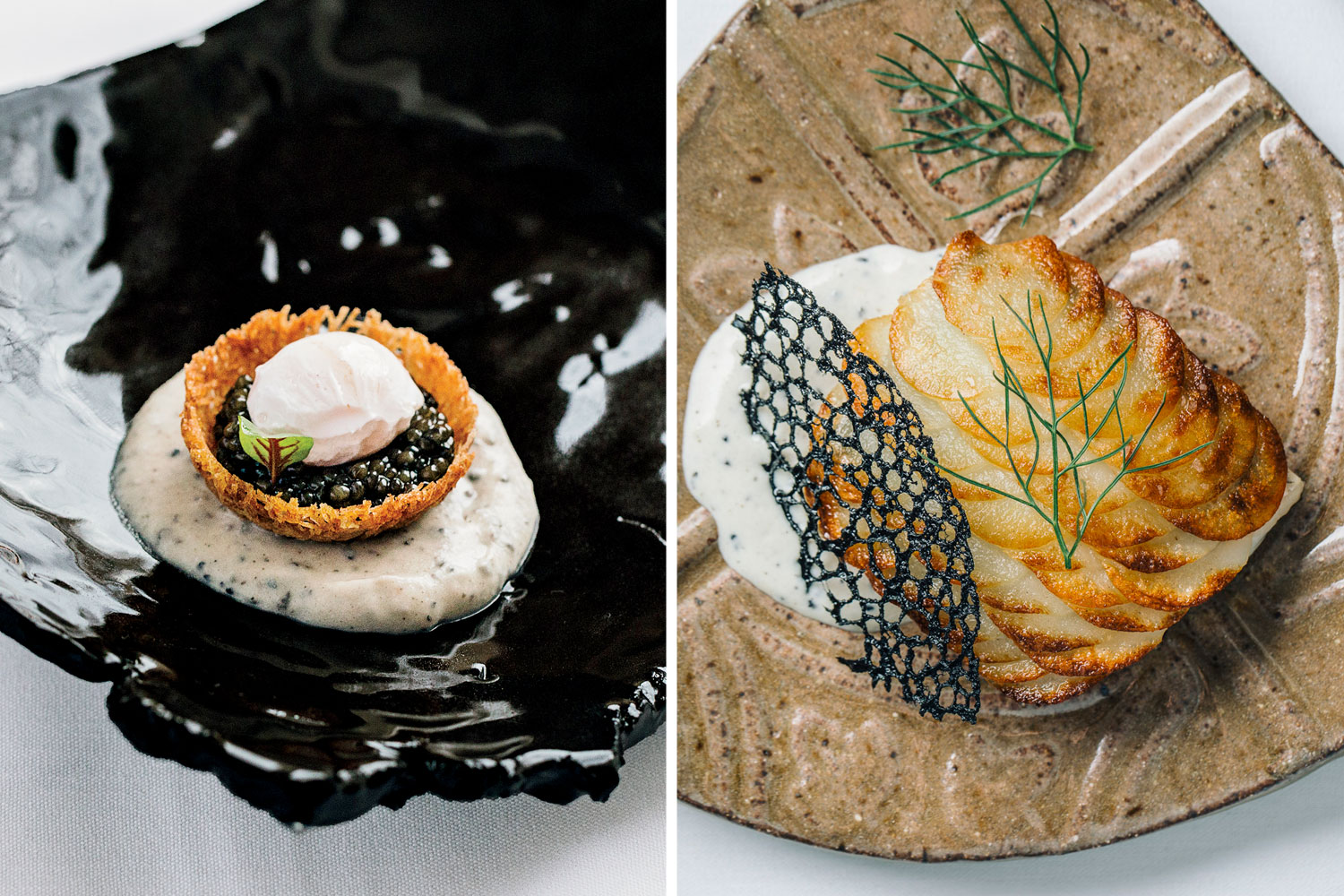The slightest pressure from my fork transforms a creamy white orb of poached quail egg into a golden burst of sunlight exploding on the horizon, yellow dissolving into the lush caviar darkness. Pan out to this composition’s frame, a crisp potato nest anchored to a shiny black plate with a luscious moon of truffled celery root soubise. And … scene.
This was the opener at my recent meal at George Trois. Before I even took a bite, I was in awe. By the time the flavors unfolded—clean, decadent, and wintry all at once—I was in love.
I wasn’t planning to fall for this place. It’s a formal French restaurant, the kind critics can’t write about without going through a certain ritual. They have to declare that this type of throwback establishment must be preserved—nay, treasured—if not particularly enjoyed. That it’s a dying breed whose gilded throne is now occupied by a bunch of interchangeable restaurants where the blandly efficient waitstaff keeps an ironic distance and the chef boast-cooks every pretentious dish for your amazement and your Instagram account. Then there must be a lament of the passing of manners, of gentility. Of hospitality itself.
But it’s all a lie, or at least a whitewashing of history. As vital as they were, many of the French restaurants in the Chicago area—say, Jean Banchet’s Le Français or Pierre Pollin’s Le Titi de Paris—overpowered diners with excess: of butter, of cream, of alcohol, of cheesy one-liners. I recall long meals were my exhilaration gave way to bludgeoning, bloating, and, ultimately, a vague sadness. Upscale restaurants today, for all their calculated cool, tend not to do those things.

That’s why I believe chef-owner Michael Lachowicz has done something special at George Trois, which opened in the fall of 2015. At age 48, he has hit his stride in the genteel, jacket-required 18-seat room adjacent to the main dining space at his North Shore fixture, Restaurant Michael. His ever-changing tasting menus capture the polished charm and attention to detail of the lusty Gallic restaurants of yesteryear (some of which Lachowicz worked at) without giving in to their sense-numbing overkill, creating something precious and beautiful and, most surprising of all, completely fresh. I did not expect to be saying this in the year 2018, but the best restaurant I’ve been to in ages is French.
Lachowicz is perfectly suited to lead such a spot, but not in the way you might expect. In his own telling, the Bartlett, Illinois, native spent years eating, drinking, and drugging himself into oblivion, eventually topping out at 432 pounds and bottoming out on the floor of his Chicago condo amid fast-food wrappers. After submitting to various support groups and getting clean in 2011, he cut his weight nearly in half. Seven years later, he’s still a workout fanatic and has rethought his approach to cooking. “Sautéing everything in butter is not interesting to me anymore,” says Lachowicz. “Besides, it’s cheating. My mom could make a shoe taste good in butter.”
A recent nine-course Périgord truffle menu at George Trois showcased his new stance. The legendary treasures of southwest France reach their peak in winter, when their famously earthy (and almost chocolaty) essence blossoms. Lachowicz, who blanches at the cliché of a chef shaving Périgords over everything, works to incorporate them in unusual ways.
He stuffs an airy rice-flour raviolo with a truffled chicken mousse that shields the dish’s ultimate treasure: a seared foie gras medallion. Slice into the packet and a rush of juices floods into the pretty pond of jus de poulet (roasted chicken stock flavored with reduced white wine) in which the raviolo rests. It’s a symbiotic marvel: The truffle and liver boost one another to new heights and yet don’t seem excessive. A similar balancing act: Under a wispy veil of black coral tuile, a skin-on black bass filet features the menu’s only cream-based sauce, a double reduction finished with a truffle purée and a squeeze of lemon. Blanched potatoes hide cooked truffle slices and retain the truffle jus’s moisture, which trickles down into the fish. Brilliant.

Even the palate cleanser is a showstopper. (Lachowicz: “Who needs sorbet when it’s 8 degrees outside?”) He steeps a truffle in Champagne, then adds more bubbly to a small gelée before it sets to give it an effervescent jolt—the perfect beat before the meal reaches its climax in an inspired play on beef Wellington. Lachowicz worked with his chef de cuisine, Miguel Escobar, to come up with the idea to butterfly and flash-sear prime tenderloin and stuff it with sliced truffles. The beef then gets packed in plastic to cure for eight hours before being wrapped in brioche and baked at a low temperature. The truffle slices permeate the tender beef from the inside until the flavor is so visceral you almost overlook the accompaniments—triumphs in their own right—of truffle-laced beurre rouge, truffled pomme purée, and cognac-steeped chanterelles.
At this point, nearly two hours into the well-paced meal, most diners would be ready to downshift. Then I saw that the upcoming course was fondue: Uh-oh, I thought, let the pummeling begin. Instead, I received a tiny, refreshingly sane portion of Foster Lake organic goat’s milk Camembert from Oregon that had been layered with sliced truffles and steamed until molten. Plus a few toasted brioche cubes, some Marcona almonds, and a handful of pickled black Mission figs. That was it.
Could the meal incorporate truffles into dessert in any sensible way? Yes, it could. A picture-perfect mini truffle soufflé mixed the usual egginess with a citrus tang and an earthy undercurrent, turning the whole thing into something weird and blunt and wonderful. The menu’s only disappointment, a jumbled “symphony” of cold-weather treats that included a dense white chocolate candy bar dusted with toasted cinnamon and crushed peppermint and served atop candied quince, never resolved into much of anything. It also happened to be the only dish that didn’t include any truffles.
George Trois’s white room, with its staid fireplace and chandelier, isn’t half as memorable as the staff. If you’ve been around awhile, pros like Daniel Gutierrez, the easygoing maître d’, and Sergio Angel, the enthusiastic wine director (both of whom I remember from Lachowicz’s days at Glen Ellyn’s Les Deux Gros), feel like old friends—but with new tricks. Angel, for one, has upped his game with unexpected wine pairings such as a creamy 2014 Domaine Jean-Marc Bernhard Gewürztraminer Mambourg that taps into the fatty essence of foie gras from a racy new angle. And, of course, there is Lachowicz himself, a refreshingly casual presence who takes your coat at the door and seems positively giddy to prepare and describe every dish.

George Trois has created a seamless continuum between tradition and modernity, and that’s no easy feat. So, chapeau to Lachowicz for not merely surviving but evolving. “I still care what people think,” he says. “But now I’m comfortable enough that I don’t give a shit if they approve.” After decades of channeling Jean Banchet and his ilk, Lachowicz has finally found the confidence and strength to mine the past and strike gold.



